There is an interesting tit-for-tat over on Open Democracy between Vron Ware and Paul Kingsnorth.
Kingsnorth writes a critical review of Ware’s book Who Cares About Britishness? Read it here.
And Ware has now responded, setting out the fundamental differences between her approach to national identity and that of Kingsnorth in Real England. She writes:
“I bought Paul Kingsnorth’s book Real England a few weeks ago after reading a positive review of it. I was enthusiastic about his project of bringing an anti-globalisation perspective to the destruction of England’s distinctive environments as I also feel passionately about this. I have been writing about a particular English locality for ten years now, tracking the impact of global forces on every area of life. I’ve also been working on and against racism and nationalism, attentive to the past and future relationships between Britain and England. When I read him I realised that there are differences between us. Now, Kingsnorth’s mean-spirited and inaccurate review of my book commissioned by the British Council, Who Cares About Britishness? A global view of the national identity debate (Arcadia, 2007) suggests that there is little common ground between us. Rather than just respond to his attack I’d like to assess his whole approach.
Kingsnorth employs the well-worn method of identifying the ‘Real England’ by travelling around the country to document a tale of damage, decline and neglect. The portrait of Englishness that he paints conveys a lament for better times, coupled with a reluctance to protest effectively at the destruction of ‘ways of life’ and institutions that once developed out of local, English culture. I thought the book would also bring an added dimension, especially since George Monbiot’s recommendation on the front cover announces that the book ‘helps to shape our view of who we are and who we want to be’……”
Read the rest of her article here.
Posted in RESEARCH | Comments Off on ENGLISHNESS VS BRITISHNESS
I just wanted to alert people to this Panel Discussion being held at The Photographers’ Gallery entitled ‘Artistic Exchange’. It sounds like it could be an interesting event. I wish I could be there.
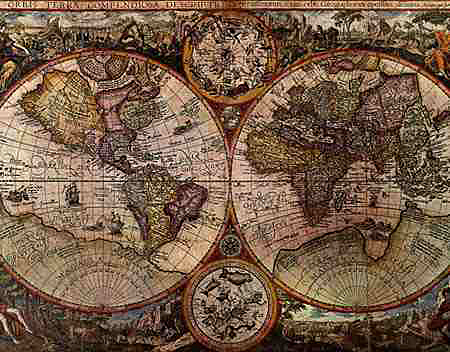
The details:
Is it useful to define an exhibition by its nationality? Can cultural distance and proximity both be advantages in the curatorial process?
Join us for a panel discussion (chaired by Dr. Isobel Whitelegg, with Egyptian artist Mahmoud Khaled, exhibiting artist Juan Pablo Echeverri and curator Camilla Brown) on how curators translate artists work.
27 May 2008 19:00
£5.00 / £3.50 concessions.
Â
Posted in RESEARCH | Comments Off on ARTISTIC EXCHANGE
Here are a few quotes I’ve come across in my research over past few weeks, which I’ve found particularly interesting or inspirational. If you have any other suggestions, please post them below.
“Happy are those who see beauty in modest spots where others see nothing. Everything is beautiful, the whole secret lies in knowing how to interpret.â€Â
Pissarro (1893). Quoted in Britain Observed by Geoffrey Grigson (1975)
“My limited and abstracted art is to be found under every hedge, and in every lane, and therefore nobody thinks it worth picking up.â€Â
Constable (1832) on declaring he had never seen an ugly thing in his life. Quoted in Britain Observed by Geoffrey Grigson (1975)
“It is part of the photographer’s job to see more intensely than most people do. He must have and keep in him something of the receptiveness of the child who looks at the world for the first time or of the traveller who enters a strange country.â€Â
Bill Brandt (1948)
“One of the pleasures of being English is to return to this country after a longish time abroad, especially if you come up the Solent in a liner….soon familiarity blinds you again, but for an hour ot two you have caught a surprising vision of your country and your countrymen: you have notice a hundred details which are peculiar to England; you have, in fact been able to look through foreign eyes.â€Â
Raymond Mortimer from the introduction to Bill Brandt’s The English at Home (1936)
 “England has a much softer atmosphere. Colours just don’t sing the way they do in the States…When I got back to England I found everything so grey that I didn’t see any point in shooting in colour. It didn’t seem to be an important part of our lives….To me Britian is very much a black and white country…â€Â
Tony Ray-Jones from an interview in SLR Camera (1969)
 “We must live in a country and work there in order to understand its ways and customs – to travel through as a tourist is to see only clichés.â€Â
Tony Ray-Jones, Notes on Jean Renoir (c.1967)
 “One can learn a good deal about the spirit of England from the comic coloured postcards that you see in the windows of cheap stationers’ shops. These things are a sort of diary upon which the English people have unconsciously recorded themselves. Their old-fashioned outlook, their graded snobberies, their mixture of bawdiness and hypocrisy, their extreme gentleness, their deeply moral attitude to life, are all mirrored there.â€Â
George Orwell, The Lion and the Unicorn (1941)
“Englishness is continuous, it stretches into the future and the past, there is something in it that persists; as in a living creature. What can the England of 1940 have in common with the England of 1840? But then, what have you in common with the child of five whose photograph your mother keeps on the mantelpiece? Nothing, except that you happen to be the same person.â€Â
George Orwell, The Lion and the Unicorn (1941)
 “England is not at all a single category but a set of relationships. The nation exists in tension. Its fellow members remain deeply divided among themselves, but at the same time they constantly prove themselves ready to unite around certain issues, talismans and images.â€Â
John Taylor, A Dream of England (1994)
“The English have not devoted a lot of energy discussing who they are. It is a mark of self-confidence: the English have not spent a great deal of time defining themselves because they haven’t needed to.â€Â Â
Jeremy Paxman, The English (1999)
“In a society of individuals, loyalties are to kindred spirits. Instead of easy-going, random meetings of street life, the English do their socialising by choice and form clubs – ‘Who runs the country?’ asked John Betjeman rhetorically. ‘The RSPB. Their members are behind every hedge.’ And he was speaking long before the RSPB membership reached its present vertiginous levels of well over one million. There are clubs to going fishing, support football teams, play cards, arrange flowers, race pigeons, make jam, ride bicycles, watch birds, even for going on holiday.â€Â
Jeremy Paxman, The English (1999)
“I hope that this apparently incongruous series of images will communicate something of the mixture of anxiety and apprehension, sadness and affection with which I view the current state of our nation.â€Â
Paul Graham from the introduction to Britain in 1984 co-published by the National Media Museum and The Photographers’ Gallery (1984)
Posted in ENGLISHNESS, INSPIRATION, RESEARCH | 1 Comment »
I’ve just come across an intriguing project called The Big Picture launched by the BBC and Arts Council which is asking participants to take a photograph which says “Englishness” to the viewer. It’s open to anyone living in the West Midlands. You’ll find more details on their website.
Posted in RESEARCH | Comments Off on THE BIG PICTURE
Don’t ask me why, but I found myself having lunch in a Morrisons cafe this afternoon- a fascinating place to people watch even if you do have to eat while listening to the constant shrill of the tills. With a few hours to kill I had a look through this year’s issue of ‘Britain in 2008- The State of the Nation’ published by the Economic & Social Research Council (ESRC). The ESRC funds research and training in social and economic issues. They are an independent organisation, established by Royal Charter, receiving most of their funding through the Department for Innovation, Universities and Skills.Â
Â
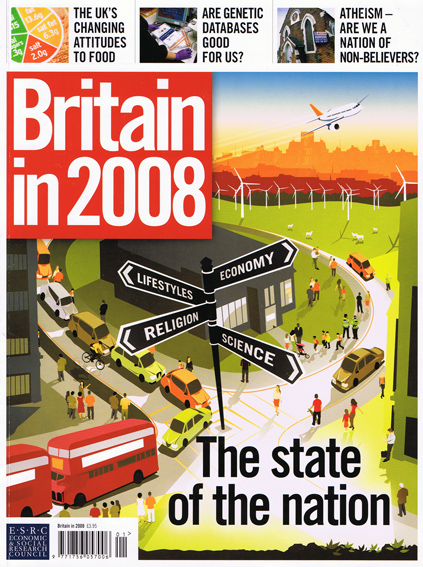
Â
Of particular interest was the ‘Britain at a Glance’ section which included the following statistics-
- In mid 2006, the UK population stood at 60.6 million. It’s an ageing population with the 80-plus the fasted growing age group. By 2050, it is likely that one quarter of the populations will be age 65-79, and ten percent 80-plus.
- Ninety two per cent of the UK population is white. Indians are the biggest single minority group, followed by Pakistanis. In the year to 2006, an estimated 565,000 immigrants arrived in the UK. The largest sender countries were Poland (9 per cent of new immigrants), India (8 per cent) and South Africa (five per cent). Over the same period, 380,000 people left the UK; Australia and Spain were the top destinations.
- One in five people in the UK live in a rural area (settlements of fewer than 10,000 people). Among the UK’s ethnic minorities only three per cent live in rural areas.
- There are more than 25 million households in the UK. Seventy per cent are owner-occupied.
- The UK’s top cities are London, Birmingham, Glasgow, Liverpool, Leeds, Sheffield, Edinburgh, Bristol, Manchester, and Leicester.
- We are living in smaller households. The average number of people per household fell from 2.84 in 1971 to 2.36 in 2001.
- The average working Briton works 1,642 hours a year (equivalent to 34 hours a week). UK workers have less paid leave than those in the European Union (200 days compared to 25-30 days in most EU countries), but more than in Japan (17 days) and the US (10 days). One quarter of the workforce work part-time; more than three quarters of part-time workers are women.
- According to the latest figures, 12.7million people live in poverty (on incomes 60 per cent of the median). Thirty per cent of people living in poverty are children and 17 per cent are pensioners.
- The average household disposable income is £445 per week. The median is £363 per week: half the population have higher incomes than this and half lower.
- The average household spends £443 a week. The biggest single spending item is transport, followed by recreation and culture, then food and drink, housing, restaurants and finally clothing.
- As a nation, we spent one third of our time sleeping, one quarter working (including housework) and one quarter on leisure activities. The biggest change since 2000 has been an increase in time spent socialising (and a fall in time spent on housework).
- According to the most recent World Values Survey, 38 per cent of Britons said they were very happy, 55 per cent said they were quite happy.
Posted in RESEARCH | 1 Comment »
The English Department at Bristol University has a specific course on Englishness for final year students, which sounds pretty interesting.
Introduction
What does it mean to be English – not British, but specifically English – and why should it matter? What national and cultural qualities does the word identify, and what has it meant in the past? Perhaps most importantly, what is the future of Englishness, and what is the future of England?
These are pressing cultural issues, and many literary critics, historians, and writers have recently turned their attention to such questions. They are also concerns that have a long history in English Literature, and have been debated and discussed for centuries. This course offers an introduction to Englishness, both its history and its literature, and presents a diverse (and ambitious) variety of material from the twelfth century to the present day. It gives a broad historical overview of certain English figures, such as King Arthur and Robin Hood, develops certain themes that characterize English identity – the Gothic, Landscape, Empire, Temper – and examines the literature of historical events such as the First and Second World Wars. The course argues that historically, Englishness has been characterized by mongrelism, hybridity, the spirit of compromise and adaptation, and linguistic capaciousness and absorption, and endeavours to explain why certain attitudes persist and how others change, and ultimately what constitutes Englishness.
For keen readers among you, here is their recommended reading list!
Peter Ackroyd, Albion: The Origins of the English Imagination (Viking, 2002)
Jane Austen, Pride and Prejudice (Oxford, 2004; ed. Fiona Stafford)
Julian Barnes, England, England (Picador, 1999)
Geoffrey Hill, Collected Poems (Penguin, 1995)
Rudyard Kipling, The Jungle Book, ed. W.W. Robson (Oxford World’s Classics, 1998)
Hanif Kureishi, The Buddha of Suburbia (Faber & Faber, 1991)
Spike Milligan, Robin Hood According to Spike Milligan (Virgin, 1999)
George Orwell, Coming Up for Air and Keep the Aspidistra Flying in Complete Novels (Penguin, 2000).
William Shakespeare, Richard II, Henry IV 1& 2, Henry V (Arden edn of RII, ed. Charles Forker; Oxford edns of remainder, ed. David Bevington, René Weis, Gary Taylor, respectively)
Bram Stoker, Dracula, ed. Maurice Hindle (Penguin, 1993)
Alfred, Lord Tennyson, Idylls of the King and a Selection of Poems, ed. J.M. Gray (Penguin, 1996)
J.R.R. Tolkien, The Lord of the Rings (Allen and Unwin, 1954-5)
P. G. Wodehouse, Uncle Fred in the Springtime (Penguin, 2004)
Michael Wood, In Search of England (Penguin, 2000)
Essays
Due in weeks 4 and 12
Suggested Weekly Plan [some selections may change]
1. Reading Week
2. Introduction: Robin Hood
Julian Barnes, England, England (Picador, 1999)
Spike Milligan, Robin Hood According to Spike Milligan (Virgin, 1999)
‘Robin Hood and Guy of Gisborn’ [course reader]
Michael Wood, ‘Merrie Englande: The Legende of Robin Hood’ in In Search of England (Penguin, 2000), 71-90.
3. Anglo-Saxon Origins
Benedict Anderson, Imagined Communities (Verso, 1991), 1-46 [course reader]
The Battle of Maldon (Norton I, 103)
Beowulf, trans. Seamus Heaney (Norton I, 29)
Thorlac Turville-Petre, ‘The Nation’ in England and the Nation: Language, Literature, and National Identity, 1290-1340 (Clarendon, 1996), 1-26 [course reader]
T.A. Shippey, ‘The Undeveloped Image: Anglo-Saxon in Popular Consciousness from Turner to Tolkien’ in Literary Appropriations of the Anglo-Saxons from the Thirteenth to the Twentieth Century (CUP, 2000), 215-36 [course reader]
J.R.R. Tolkien, ‘Beowulf: The Monsters and the Critics’, Proceedings of the British Academy 22 (1936) [course reader]
Michael Wood, ‘The Norman Yoke’ and ‘When Was England England?’ in In Search of England, 1-22, 91-106
4. King Arthur
Geoffrey of Monmouth (Norton I, 115)
Layamon, from Brut (Norton I, 122)
‘The Myth of Arthur’s Return’ (Norton I, 124)
Thomas Malory, Morte Darthur (Norton I, 419)
William Morris (Norton II, 1605)
Alfred, Lord Tennyson, Idylls of the King and a Selection of Poems, ed. J.M. Gray (Penguin, 1996): focus on the ‘Dedication’, ‘The Coming of Arthur’, ‘The Holy Grail’, ‘The Passing of Arthur’, and ‘To the Queen’
[Tennyson, Idylls of the King (Norton II, 1282)]
Michael Wood, ‘Glastonbury, the Grail and the Isle of Avalon’ in In Search of England, 43-70
5. Reflections [essay week]
Geoffrey Hill, Collected Poems (Penguin, 1995) [especially ‘Mercian Hymns’, 105-34]
[Geoffrey Hill (Norton II, 2717)]
Philip Larkin (Norton II, 2564)
6. Shakespeare and History
Richard II, Henry IV 1 & 2, Henry V (Arden edn of RII, ed. Charles Forker; Oxford edns of remainder, ed. David Bevington, René Weis, Gary Taylor, respectively)
Make sure you also study the passages from Holinshed in these editions
7. Gothic
Edmund Burke, from Reflections on the Revolution in France (Norton II, 121); ‘A Philosophical Enquiry into the Origin of Our Ideas of the Sublime and Beautiful’ [course reader]
Samuel Johnson, Prefaces to Dictionary and Shakespeare, and Lives (Norton I, 2719)
John Ruskin (Norton II, 1425)
Bram Stoker, Dracula, ed. Maurice Hindle (Penguin, 1993)
8. Romantic Ecology
William Blake, ‘And did those feet’ (Norton II, 85)
John Clare (Norton II, 802)
Robert Coll, ‘England as a Garden’ in The Identity of England (OUP, 2002), 203-11.
William Cowper (Norton I, 2875)
John Keats, ‘To Autumn’ (Norton II, 872)
Andrew Marvell, Garden Poems and ‘Upon Appleton House’ (Norton I, 1694, 1704)
James Thomson (Norton I, 2822)
William Wordsworth, The Prelude (Norton II, 303)
9. Temper and Class
Jane Austen, Pride and Prejudice (Oxford, 2004; ed. Fiona Stafford)
Daniel Defoe, ‘The True-Born Englishman’ (course reader)
Jeremy Paxman, ‘The Ideal Englishman’, in The English (Penguin, 1999), 176-206 [course reader]
P. G. Wodehouse, Uncle Fred in the Springtime (Penguin, 2004)
10. Empire
Empire (Norton II, 2017)
Benedict Anderson, ‘Census, Map, Museum’ in Imagined Communities, 163-86 [course reader]
Rudyard Kipling (Norton II, 1863); The Jungle Book, ed. W.W. Robson (Oxford World’s Classics, 1998)
Hanif Kureishi, The Buddha of Suburbia (Faber & Faber, 1991)
Salman Rushdie, Imaginary Homelands (Penguin, 1992) [course reader]
Michael Wood, ‘Epilogue: An English Family’ in In Search of England, 292-306
11. The Wars
Poetry of the Great War (Norton II, 2048)
Poetry of the Second World War (Norton II, 2525)
George Orwell (Norton II, 2456)
George Orwell, Coming Up for Air and Keep the Aspidistra Flying in Complete Novels (Penguin, 2000)
12. Reinventing the Mythology of England
Chris Hopkins, ‘Tolkien and Englishness’ in Proceedings of the J.R.R. Tolkien Centenary Conference, ed. Reynolds and Goodnight, 278-80 (course reader)
J.R.R. Tolkien, The Lord of the Rings (Allen and Unwin, 1954-5) [especially descriptions of the Shire in books one and six]
Further Reading
Benedict Anderson, Imagined Communities (Verso, 1991)
Antony Easthope, Englishness and National Culture (Routledge, 1998)
Jonathan Bate, Romantic Ecology (Routledge, 1991)
Jonathan Bate, The Song of the Earth (Picador, 2001)
Ian Baucom, Out of Place: Englishness, Empire and the Locations of Identity (Princeton University Press, 1998)
Angus Calder, The Myth of the Blitz (Pimlico, 1992)
David Peters Corbett, The Geographies of Englishness: Landscape and the National Past, 1880-1940 (Yale University Press, 2002)
The Country and the City Revisited, ed. Gerald MacLean, Donna Landry, and Joseph Patrick Ward (Cambridge UP, 1999)
David Crystal, The Stories of English (Penguin, 2004)
England and Its Aesthetes: John Ruskin, Walter Pater, Adrian Stokes, ed. David Carter (Routledge, 1997)
Englishness, ed. Philip Dodd and Robert Colls (Routledge, 1987)
Paul Fussell, The Great War and Modern Memory (Oxford UP, 1975)
Samuel Gikandi, Maps of Englishness: Writing Identity in the Culture of Colonialism (Columbia University Press, 1997)
Stephen Gill, Wordsworth and the Victorians (Oxford UP, 2001)
Paul Gilroy, There Ain’t No Black in the Union Jack (Routledge, 1987)
Peter Haydon, Beer and Britannia (Sutton, 2001)
Stephen Knight, Robin Hood (Blackwell, 1994)
Krishan Kumar, The Making of English National Identity (Cambridge University Press, 2003)
Donna Landry, The Invention of the Countryside (Palgrave, 2001)
Paul Langford, Englishness Identified: Manners and Character 1650-1850 (Oxford UP, 2001)
Literature in the Modern World: ‘Englishness’, ed. A. Calder, R. Day, G. Martin (Open UP, 1991)
John Lucas, England and Englishness: Ideas of Nationhood in English Poetry, 1668-1900 (Hogarth, 1991)
David Matless, Landscape and Englishness (Reaktion, 2001)
Nikolaus Pevsner, The Englishness of English Art (Penguin, 1993)
Our Englishness, ed. Tony Linsell (Anglo-Saxon, 2000)
Jeremy Paxman, The English (Penguin, 1999)
The Post-colonial Studies Reader, ed. Bill Ashcroft, Gareth Griffiths, Helen Tiffin (Routledge, 1994)
Robin Hood: An Anthology of Scholarship and Criticism, ed. Stephen Knight (Brewer, 1999)
Salman Rushdie, Imaginary Homelands (Penguin, 1992)
Edward W. Said, Culture and Imperialism (Viking, 1994)
Simon Schama, History of Britain (BBC, 2002)
Roger Scruton, England: An Elegy (Pimlico, 2001)
T.A. Shippey, J.R.R. Tolkien: Author of the Century (HarperCollins, 2000)
T.A. Shippey, Literary Appropriations of the Anglo-Saxons from the Thirteenth to the Twentieth Century (CUP, 2000)
Gary Taylor, Reinventing Shakespeare (Chatto & Windus, 1990)
Thorlac Turville-Petre, England and the Nation: Language, Literature, and National Identity, 1290-1340 (Clarendon, 1996)
Wendy Webster, Englishness and Empire 1939-1965 (Oxford University Press, 2005)
Raymond Williams, The Country and the City (Hogarth, 1985)
The White Man’s Burdens, ed Chris Brooks and Peter Faulkner (Exeter UP, 1996)
P.G. Wodehouse, Life at Blandings (Penguin, 1981)
P.G. Wodehouse, Imperial Blandings (Penguin, 1993)
Posted in ENGLISHNESS, RESEARCH | Comments Off on ENGLISHNESS, A RECOMMENDED READING LIST
An important element to the success of We English is an active engagement with you, the English public. I’m therefore encouraging visitors to this website to post YOUR IDEAS regarding events happening in your locale or hobbies and pastimes that you take part in, and that you’re happy for me to attend and photograph. I believe this collaboration will enable me to get a broader spectrum of coverage across themes and geographical locations, while also helping to find subject matter that is not part of the mainstream.
I’m interested in any ideas, the only proviso is that they take place outdoors, during daylight hours and are held in 2008.
The first 150 people to submit an appropriate idea will receive a limited edition, signed print from We English (see below), provided a valid postal address is given.
Ideas could include: beach combing, bikers, bowling, car boot sales, carninvals, church fetes, classic car rally, climbing, coursing, Cumberland wrestling, family rituals, farmers markets, fell running, gardening, greyhound racing, hound trailing, hunting, nudists, pagan events, paintballing, photography conventions, picnics, plane spotting, polo, raves, religious festivals, roller discos, spectator sports, stock-car racing, talent contests and twitching.
Events and pastimes I’ve already covered include (in no particular order): Laughton Country Show, Shoreham Airshow, banger racing at Arlington Stadium and Wimbledon Raceway, para-gliders on Devil’s Dyke, ramblers walking the Seven Sisters near Beachy Head, Christmas market in Salisbury, Pooh Sticks Bridge in Ashdown Forest, Middle Farm Apple Festival in Firle, Arundel Park, Lewes Bonfire Night, skate-park in Chatham, Stanmere Park in Brighton, pheasant shooting in Bramley and Finchdean, painters in Chichester’s Priory Park, Limpsfield Golf Course, runners in Knole Park Sevenoaks, swimmers in the Serpentine on Christmas Day, shoppers heading to the Boxing Day sale at Bluewater, fox hunting in Berkshire, the Haxey Hood, the Maldon Mud Race, Sunday league football at Hackney Marshes, allotments in Worthing, surfers in Goring-by-Sea and Bournemouth, London Harness Horse Parage at South of England Showground in Ardingley, jogging along River Cam in Grantchester, dry skiing in Welwyn Garden City, day-trippers to Flatford Mill, sea fishing by Sizewell Power Station, bird watchers in Titchwell, half term holidaymakers on Holkham Beach, blue bell walk in Walsingham, visitors to Great Yarmouth, Richmond Park, Midhurst rugby club, pigeon lofts in Hillsborough district of Sheffield, Easter egg trail around Priory Farm in Nutfield, British Marbles Championships in Tinsley Green, Easter Sunday in Chartwell, the Oxford and Cambridge Boat Race, Ladies Day at Aintree and sledging on Tandridge Golf Course in the April snow.
“Henry playing, Oxted, 2007”
Signed 6×4″ C-Type print from a limited edition of 150
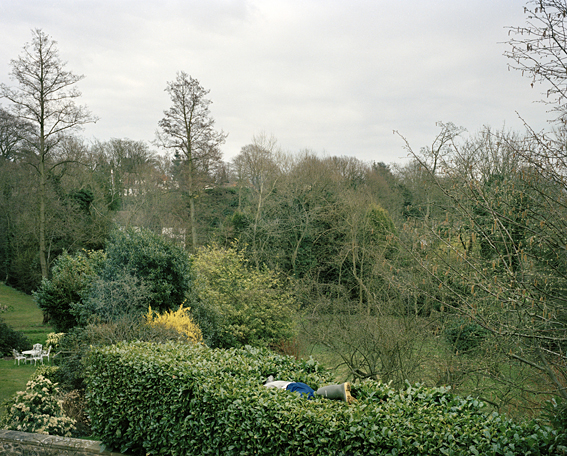
Â
Â
Posted in RESEARCH | 1 Comment »
As I’ve mentioned previously, We English aims to extend, and reflect upon, a rich history of documentary photographic projects by British photographers that have aspired to capture the lives of diverse communities across the country and explore issues surrounding national identity. Some of which could be seen in the recent exhibition at Tate Britain ‘How We Are – Photographing Britain’ (2007).
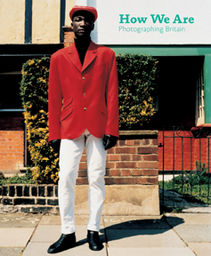
Â
I’ve compiled a timeline of major photographic projects that have been concerned with documenting the social, political or cultural landscape of England/Britain. Not all these bodies of work were published as books (for instance Another Country by Chris Killip & Graham Smith was an exhibition at the Serpentine), while some have been published much later after the photographs were produced (such as James Ravilious’ An English Eye). You can find links to many of the works under the ‘Photography’ section on the side panel.
This is not an exhaustive list, rather work I have come across over the years and which has proved inspirational in my research for We English. Please free free to add your suggestions of important work that I may have missed.
Timeline-
Benjamin Stone, A Record of England (1897-1910. Published 2006)
Bill Brandt, The English at Home (1936)
Humphrey Spender, Worktown, (1938)
The ‘Young Meteors’ – a generation of British photographers including Phillip Jones Griffiths, Don McCullin, Roger Mayne, Nigel Henderson, John Bulmer, Terence Donovan and David Hurn (1960s. Published 1999)
Jane Bown, The Unknown Bown (1947-67. Published 2007)
The John Hinde Butlins Photographs (1960-70s)
Tony Ray-Jones, A Day Off (1974)
Patrick Ward, Wish You Were Here – The English at Play (1976)
Homer Sykes, Once a Year- Traditional British Customs (1977)
Ian Berry, The English (1978)
Paul Graham, A1 – The Great North Road (1983)
Chris Killip & Graham Smith, Another Country (1985)
Raghubir Singh, Bradford Fellowship- National Media Museum (1985-86)
Martin Parr, The Last Resort (1986)
Peter Marlow, The Liverpool Project (1987)
Ingrid Pollard, Pastoral Interludes (1988)
Chris Killip, In Flagrante (1988)
Anna Fox, Workstations (1988)
Martin Parr, The Cost of Living (1989)
Chris Steele-Perkins, The Pleasure Principal (1989)
Paul Reas, Flogging a Dead Horse (1993)
John Kippin, Nostalgia for the Future (1995)
Mark Power, The Shipping Forecast (1999)
Martin Parr, Think of England (2000)
Richard Billingham, Ray’s A Laugh (2000)
Nick Danziger, The British (2001)
Jem Southam, Landscape Stories (2005)
Jan Williams & Chris Teasdale, Welcome to Britain (2005)
John Davies, The British Landscape (2006)
Harry Cory Wright, Journey Through the British Isles (2007)
Don McCullin, In England (2007)
James Ravilious, An English Eye (2007)
Posted in RESEARCH | 3 Comments »
Having done a few initial test shoots with the Mamiya 7 camera, samples of which you can see below from my scrap book, I’ve decided to go up to a larger format and exclusively use a 5×4 camera for We English. I’ll discuss reasons why in a post to follow.
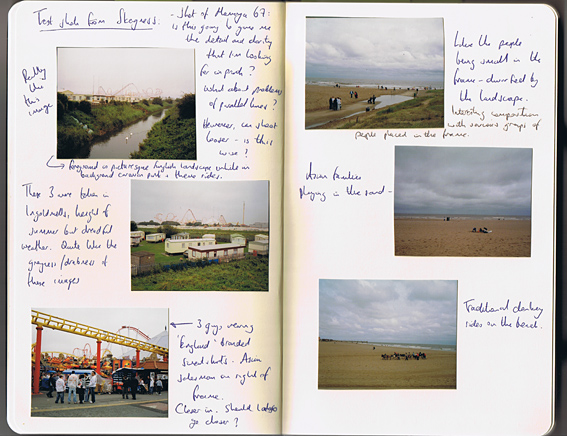
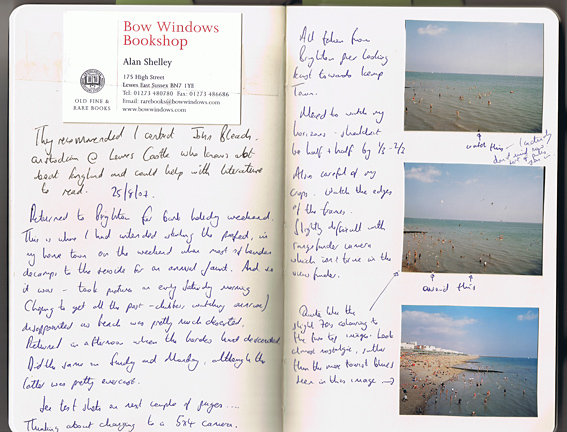
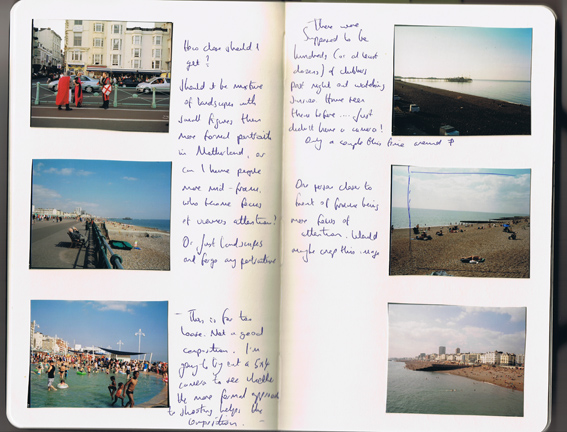
Posted in RESEARCH | Comments Off on PAGES FROM MY SCRAP BOOK
We English aims to be a rich, extensive and nuanced corpus of images that help create a new dialogue in the photographic analysis of contemporary English society and the challenging notion of Englishness, and which extends a rich history of British photographers documenting their homeland.
After spending two years producing a book about Russia and Russian identity (Motherland published by Chris Boot Ltd), I began in turn to think about my own homeland and about the concept of Englishness and all its complexities.
We English will be a sustained photographic documentation of England in 2008. My aim is to create a photographic journal of life, specifically documenting landscapes where groups of people congregate for a common purpose and shared experience. It will be about what people do in their spare time, their leisure pursuits and pastimes and how people derive meaning and identity from these activities. It will also be about people’s relationship with their environment, whether their immediate surroundings are urban or rural. Recreation will provide the basis for a wider exploration of people’s attachment to place and the way in which the inhabitants of England derive meaning and identity from everyday events and activities. The project will focus on events that take place on a local level and at locations where everyday rituals are played out. (While traditional communities have weakened, our attachment to locality remains strong and provides an important expression of identity.) [1]
Logistically, We English will take the form of a series of journeys around England in a motorhome (the main journey being from April until September when I will be joined by my wife and daughter). The journeys will be based on my own research together with ideas sourced via this website where I’m encouraging you, the general public to post details about events and share information about your ideas on the notion of Englishness and how it relates to you. This collaboration will be important in dealing with the complex issues surrounding notions of cultural representation and will also enable me to access a broader spectrum of themes and geographical locations. Moreover, We English will be a pilgrimage of sorts, where I will seek out those places that I believe have helped shaped my own feelings of Englishness.
The project will extend, and reflect upon, a history of documentary photographic projects and the variety of approaches that British photographers have utilised to capture the lives of diverse communities across the country and explore issues surrounding national identity and the constantly shifting notion of Englishness. [2] The long and rich tradition of British photographers documenting their homeland, some of which could be seen in the recent exhibition at Tate Britain ‘How We Are – Photographing Britain,’ has seen work produced by the likes of Humphrey Spender, Bill Brandt, Tony Ray Jones, Ingrid Pollard, Martin Parr, John Davies and Jem Southam to name a few. However, the past decade has seen relatively little work produced by British photographers. [3]
We English will draw on aspects of human geography and on cultural geography, particularly. [4] Since landscape has long been used as a commodity, an aesthetic amenity that is there to be consumed, it makes sense to use leisure activities, no matter how banal they might appear, as a way into an exploration of England’s shifting cultural and aesthetic identity. Whilst I hope to produce images that are nuanced and beautiful, even elegiac, they will nonetheless explore that ways in which landscape can also become a place of conflict, a place where received ideas about nationhood and quintessential Englishness are challenged.
I am interested in the reality of an England at this time of rapid social and cultural flux but am not seeking to overturn stereotyped images of traditional English scenes. (This has already been admirably achieved by John Kippin, Ingrid Pollard and others.)Â We English will yield contemporary visions of my country that recognise the narrowness of long-held mental images of England and explore the ambiguities and complexities of our place within the world around us in a manner that amplifies and extends meaning.
Footnotes-
[1] Recent research by the Economic & Social Research Council shows that the community that really matters to people is very geographically local. Source: ESRC- ‘Britain in 2008’. Statistics show that two-thirds of people live within five miles of where they were born; local radio attracts 25 million listeners a week in contrast to an average of 13 million to Radio 2; and while 60-70% of us read a national newspaper daily, 80-84% will read a local newspaper. Source: Julian Baggini, ‘Welcome to Everytown’.
[2] I’m interested in the concept of Englishness, as opposed to Britishness, which has become increasingly complex since devolution. A recent study by the ESRC also found that many English respondents wanted to ‘shrink’ their British identity to a more localized English one like those of the Scots, Welsh and Irish. Furthermore, geographically England dominates the UK, accounting for nearly 85% of its population.
[3]Â Examples of more recent studies would be the work of The Caravan Gallery by Jan Williams & Chris Teasdale and The Folk Archive by Jeremy Deller & Alan Kane.
[4] The work will explore the connection between the imaginative geography of landscape and the ‘imagined community’ (Benedict Anderson, 1983), where Anderson argues that England as a nation is not directly experienced by its inhabitants in the same, unifying manner but rather that the concept is tied together by a range of images held in the minds of its fellow-members.
Posted in RESEARCH | Comments Off on ABOUT WE ENGLISH








